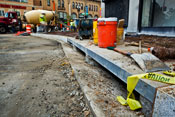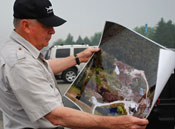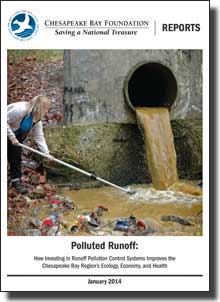We believe that the best strategy for reducing runoff pollution combines the following four elements. This overview represents the standards CBF advocates; these may be higher than those currently in place in any particular location.
- Prevention: Planning and Zoning—Through comprehensive plans and zoning ordinances, local jurisdictions decide where development should occur, how much development is allowed, and the amount of open space or working land in a community that must be conserved or protected from such development. Steering development away from sensitive areas where polluted runoff does the most harm and protecting wooded and other open spaces that can naturally filter rainwater are both critical strategies for reducing stormwater pollution levels in the Bay.
-
Design, Construction, and Post-Construction—Once new development is approved and goes forward, an important consideration is the design and construction of the specific sites. These elements are often controlled by local subdivision, stormwater, and sediment and erosion control ordinances. A site under construction is a potential hot-spot for polluted runoff. Unless effective erosion and sediment control measures are designed well and adequately implemented, a rainstorm or snowmelt can wash large amounts of sediment and debris into the nearest stream, impairing local water quality. It's crucial to minimize both the amount of runoff and the amount of land exposed, as well as the amount of time soil is exposed to the elements. The latter should be no more than 72 hours after construction temporarily or fully ceases.

Krista Schlyer/iLCP
Once construction is complete, redevelopment projects should at least manage their sites and buildings for the full "water quality volume" of stormwater—about an inch of runoff, more or less, across the Chesapeake Bay watershed. New development projects should manage for full "channel protection volume," a greater amount of water. This prevents runoff from adversely affecting nearby streams. New development sites should also use "low impact" and "environmental design" techniques (also called "green infrastructure") that mimic the natural flow and filtration of water, if at all possible.
-
Enforcement—Ordinances, construction management practices, and environmental site design standards are meaningless unless people follow them. When construction sites are not adequately monitored and requirements are not strictly enforced, development can cause enormous damage to nearby streams. If polluted runoff management practices are not regularly inspected and maintained long after construction is complete their ability to function properly cannot be guaranteed.

Susan Zox, courtesy Hendrick Smith Productions)
- Permits—The federal Clean Water Act (CWA) requires the largest municipalities to obtain and hold permits for their stormwater discharges (called "Municipal Separate Storm Sewer System Permits," or MS4s). Some of these permits in the Chesapeake Bay region may be outdated (meaning more than five years old) and may have been extended by state government pending new ones. Even the newer permits still have weak requirements and are not as accountable as they should be.
Permits for many of the largest jurisdictions in Maryland and Virginia will be renewed and updated between 2018 and 2020. Pennsylvania's 20118 General Permit, covering the jurisdictions of that state within the Chesapeake Bay watershed, require localities to send in a notice of intent (application) to be covered. Most have done so.
Maryland and Virginia's environmental agencies have pledged to update and strengthen the permits for large counties and cities to help meet pollution limits for the Chesapeake Bay. Stronger runoff permits will help the states implement the Chesapeake Clean Water Blueprint, to reduce pollution from all sources, and clean up local streams. Urban and suburban polluted runoff is a local problem begging local solutions and promising local benefits, as well as larger benefits to the Chesapeake Bay.
Additional information about stormwater management can be found at the following websites:
The Center for Watershed Protection
Low Impact Development Center
Low Impact Development Urban Design Tools



